Andong melds the past and present in complete harmony. Retracing the footsteps of ancestors, it becomes clear why the city is the epicenter of Korea’s spiritual culture. After a day of touring, hungry sightseers soon realize that Andong is also the birthplace of many dishes that capture the hearts of foodies today.
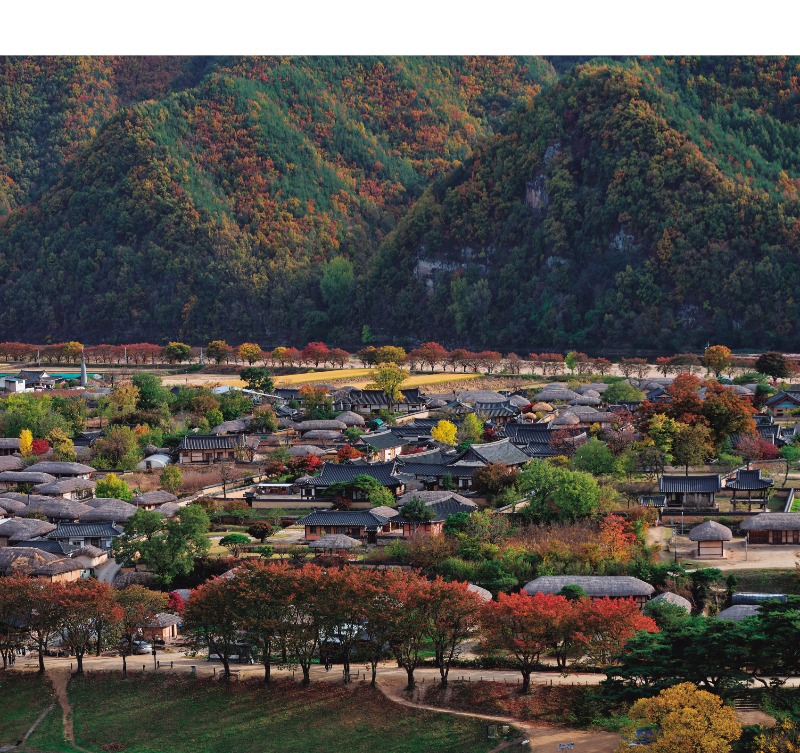
.
At the entrance to Hahoe Village is a placard that reads, “I will never forget the day in 1999 when Queen Elizabeth II visited Andong.” The queen, who had been invited to Korea by the then President Kim Dae-jung, expressed her desire to see whatever is the “most Korean.” The answer was Andong, the capital of North Gyeongsang Province. It is where the essence of the Korean spirit can be found, embedded in the largest number of UNESCO World Heritage sites in Korea, and indeed all over the city.
Upon arriving in Andong on her 73rd birthday, Queen Elizabeth was escorted by actor Ryu Si-won to Damyeonjae, a gracious old traditional house where Ryu was born as the 13th-generation descendant of Ryu Seong-ryong, a famous civil official of the mid-Joseon Dynasty. There, a Korean-style birthday meal was laid out for the queen, which included Andong noodles, pressed meat slices, braised meat, soup and Andong soju.
The queen also attended a performance of the Hahoe Byeolsingut Talnori, a masked dance-drama based on community rites native to Andong, as well as a demonstration of preparing gochujang (red pepper paste) and kimchi. When she visited Chunghyodang (House of Loyalty and Filial Piety), the head house of the Pungsan Ryu clan, she surprised everyone by taking off her shoes and stepping inside in her stockinged feet, in accordance with Korean etiquette. In front of Geungnakjeon (Hall of Paradise) at Bongjeong Temple – the oldest extant wooden building in Korea, erected in the early 1200s during the Goryeo Dynasty – the queen placed a stone at the very top of a cairn as people around her watched anxiously, hoping the whole stack would not collapse. Onlookers explained that placing a stone on the stack was a way of making a wish.
CONFUCIAN HEREDITY
To properly understand the city of Andong, we need to recognize that Confucianism was the DNA underpinning the 500-year-old Joseon Dynasty. As soon as the state adopted Confucianism as its guiding ideology, certain attitudes and practices were born that are considered quintessentially Korean. They included a male-centered social structure and deference to one’s elders.
Today, Korean Confucianism remains alive in Andong in its original form, preserving the legacy of Yi Hwang (pen name: Toegye, 1502-1571) and Ryu Seong-ryong (pen name: Seoae, 1542- 1607), who were both born in Andong and became leading figures of the Yeongnam School of Neo- Confucianism.
The starting point of any exploration of the city has to be Hahoe Village. Hahoe is a well-preserved traditional clan enclave. It is designated as Important Folk Material No. 122 and home to two national treasures, four other designated treasures, and eleven folk materials. The village’s name means “water flowing in winding fashion,” and refers to the way Hwacheon, the upstream part of the Nakdong River, flows around the village in an “S” shape that is reminiscent of the red and blue Taegeuk symbol in the center of Korea’s national flag, or of a lotus blossom floating on water. That makes Andong an auspicious place since ancient times, in geomantic terms.
Old Korean villages look very similar, but Andong is particularly appealing because it is not just a huge outdoor museum where time seems to have stopped, but a living community where residents tend to their daily routines as they mingle among tourists. As you walk around reading the name boards of the old houses such as Hwagyeongdang (House of Harmony and Respect) and Yangjindang (House of Truth Cultivation), you might see milk delivery bags hanging on the front gate, or young radishes and lettuce planted neatly in the adjacent fields.
Not far from Hahoe is Byeongsan Seowon, a Neo-Confucian academy that is dedicated to Ryu Seong-ryong. Seowon were private educational institutions where the country’s finest minds gathered to teach and learn. The disciples of Ryu Seong-ryong gathered at Byeongsan Seowon and the disciples of Yi Hwang at Dosan Seowon, also located in Andong.
Byeongsan Seowon is considered one of the most beautiful Confucian academies in the country. Its architecture gracefully complements and enhances the surrounding natural environment. Mandaeru, an elevated pavilion at the academy’s entrance, offers exquisite views of the wide Nakdong River below and the academy’s eponymous mountain, Byeongsan (Mt. Byeong), across the way.
Dosan Seowon is on a grander scale than Byeongsan Seowon. During his later years, Toegye Yi Hwang built a village school called Dosan Seodang and taught there. After his death, his disciples built Dosan Seowon around the school. The school and the Confucian academy remain on the same site today in honor of Yi Hwang’s great learning. Stepping through the main gate into Dosan Seowon, on the left is the dormitory named Nongunjeongsa, where Yi Hwang’s disciples lived and studied. Further to the back is Jeongyodang (Hall of Classical Teachings), a lecture hall with views over the tranquil scenery of Andong, where scholars gathered for discussions and large meetings.
At the Seonbi Culture Training Center, a two-day course is offered to learn about and experience the life of a Confucian scholar, or seonbi. This popular class provides opportunities to dress in the typical Confucian scholar’s robes; explore the Confucian academies, the head house of Yi Hwang’s family clan, and Yi Yuk-sa Literary Museum; and stroll along Toegye Meditation Road under the soft moonlight.
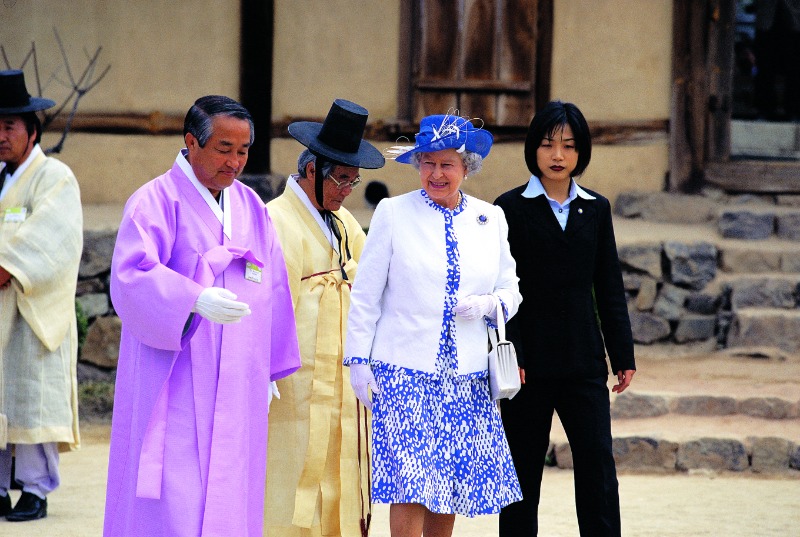
A photo of Queen Elizabeth II when she visited Andong in 1999. Arriving in the city on her 73rd birthday, she sat down to a traditional Korean birthday meal, explored Hahoe Village and Bongjeong Temple, and watched a performance of Hahoe Byeolsingut Talnori.
© ANDONG-CITY
GOURMET CITY
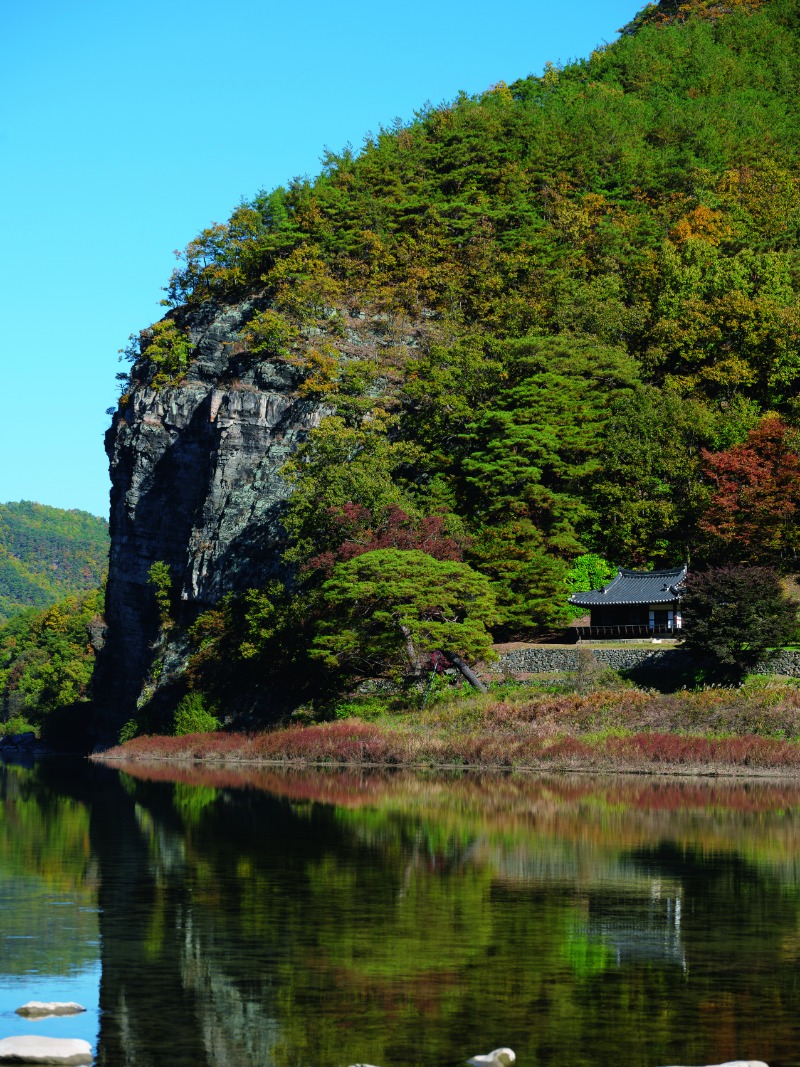
Gosanjeong, a pavilion built by Geum Nan-su (1530-1599), a scholar of the mid-Joseon Dynasty and a disciple of Yi Hwang. It sits beautifully in its natural setting and is a prime example of a Joseon pavilion.
The atmosphere of markets is a good way to measure a city’s vitality. Andong has several large markets, including Gusijang, or the “old market.” This is a famous foodie paradise with its galbi alley lined with restaurants selling beef short-rib dishes, jjimdak alley packed with braised chicken eateries, and Mammoth Bakery, an old local institution.
For food lovers, Andong is a revered place for traditional food. Even several days would not suffice to sample enough dishes. Think kalguksu, a soup with wide, flat hand-made noodles, is too ordinary? Try Andong guksi, made with thinner noodles that seem to be quivering on top of the soup. The only downside is the danger of overeating, because the soft noodles go down so easily. An indispensable dish for drinkers is gukbap,literally meaning “soup and rice.” It is almost always eaten with alcohol, or in the morning after a night of drinking. It claims an important place in Korea’s culinary culture, and the Andong version, filled with seasonal radish and Korean beef, is a favorite with people of all ages.
With so many clan head houses in Andong, ancestral rites were (and are still) frequently held, giving rise to the custom of taking food leftover from the ritual table and mixing it all together in a bowl with sauce to make goldongban. Today, it is more commonly known as bibimbap. Later, restaurants began to prepare the same foods found on ritual tables so that customers could eat bibimbap at any time. When not eaten after a rite, this meal is called heotjesatbap, which means “not real ritual food.”
Another famous dish of the city is Andong jjimdak. When the craze for yangnyeom chicken (fried chicken coated in a sweet and spicy sauce) hit more than a decade ago, the merchants of Andong’s old-style chicken alley had to find a competitive response. They d jjimdak, chicken braised in spicy, salty seasoning with thick glass noodles and vegetables, which spread throughout the country. Salted mackerel is also an Andong specialty, the result of the ancestors’ wisdom of preserving and transporting fish to this inland city far from the sea.
While it is easy to spend days enjoying the local food without getting tired of it, young chefs in Andong also offer some completely new creations featuring traditional ingredients, for instance Andong mackerel pasta or salted mackerel burgers. The wonderful thing about the city’s old markets is that they are not stuck in the past but blend old and new in interesting ways.
After a good meal, the natural course is to stroll along Woryeong Bridge, or Bridge of the Moon’s Reflection. On a dark night, the story of “Won’s mother” resonates like the light spreading on the Nakdong River. Nearby the wooden bridge, built in modern times, a letter was found written by “Won’s mother,” a Joseon Dynasty woman, that is full of regret, longing and resentment for her husband, who died before their child was born.
For couples, it is a story to ruminate on while cruising the Nakdong River on one of the little moon-shaped boats. The area around the bridge is now dotted with all kinds of accommodation, including new hotels and hanok resorts filled with traditional houses. There are also theme parks like Zootopium and Confucian Land, offering an entirely different type of entertainment and mood to the quiet elegance of the old houses.
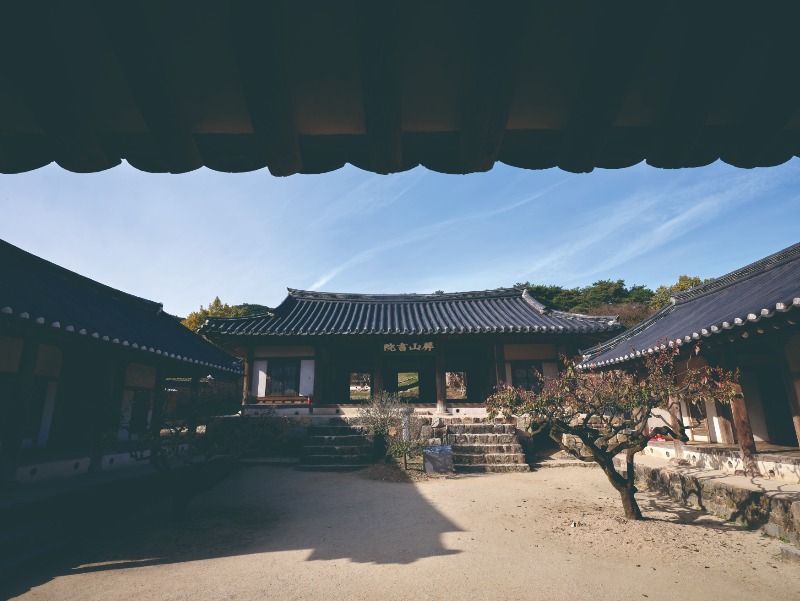
Byeongsan Seowon, a Confucian academy built in 1572 in honor of Ryu Seong-ryong, is considered the epitome of Korea’s Confucian architecture. It was inscribed on the UNESCO World Heritage List with eight other Confucian academies in 2019 in recognition of its architectural beauty and harmony with its spectacular surrounding landscape.
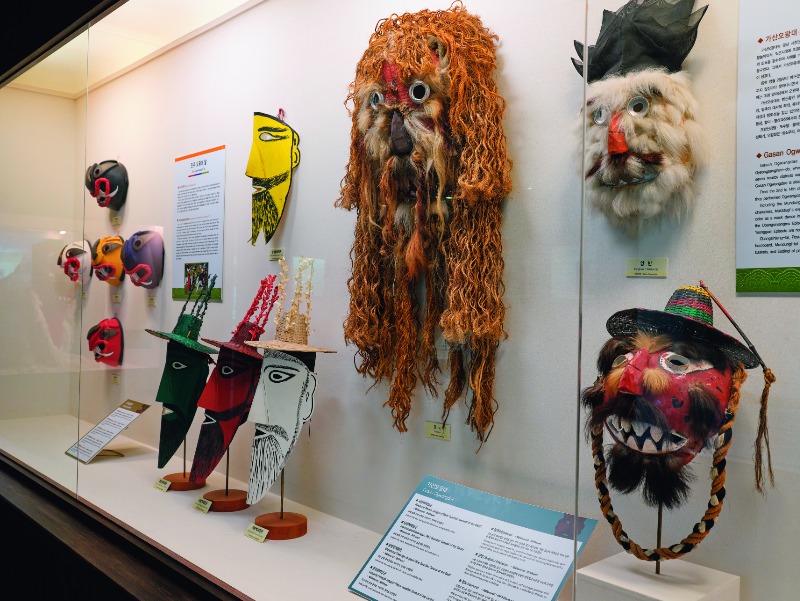
The Hahoe Mask Museum opened at the entrance to Hahoe village in 1995. It houses 250 Korean masks, including those used in Hahoe Byeolsingut Talnori, a masked dance-drama performance handed down in the village, as well as 250 masks from around the world.
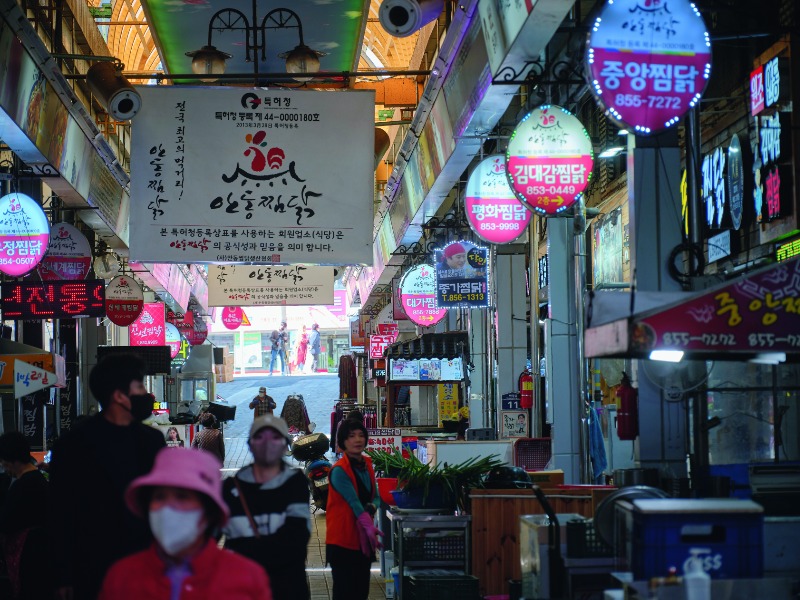
Gusijang, the old market area located in the center of Andong, has an alley filled with more than 30 restaurants serving the original taste of Andong jjimdak, one of the signature dishes of the city.
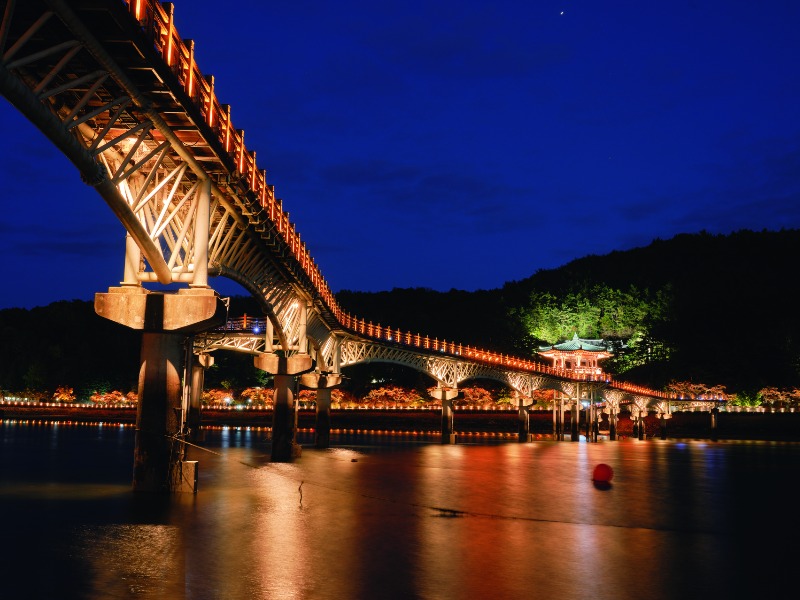
The pavilion on Woryeong Bridge, the longest wooden bridge in Korea, provides a wonderful view over Andong Dam. On the water, tourists relax on colorful “moon boats” or traditional sailing boats.
OLD AND NEW
Not long ago I visited Las Vegas. I felt as if I had seen the rise and fall of a once dazzling city. The Volcano Show and Fountain Show were the same as ever, but they had the desolate air of a tired middle-aged person seen from behind. Caesars Palace and the Bellagio Hotel, once the epitome of bright lights and splendor, also seemed exhausted, although the city was still filled with tourists. When I think about Andong in comparison, there is something fresh about the changing face of this ancient Korean city.
More than 20 years ago, there was no ticket booth or village shuttle bus, or any other form of convenience, but since then, the village has been completely reorganized to accommodate easy walking tours. The Hahoe Mask Museum, located some way before the village entrance, is like an appetizer before the main course. It is decorated with the smiling Hahoe masks (National Treasure No. 121) that Koreans are so familiar with, as well as various masks from around the world.
Moving rather than standing still, discovering new stories, and making improvements – these struck me as characteristics not only of Andong but Korea. In the city, old stores passed down for generations are found among trendy new restaurants, and old houses, in danger of being submerged when the Andong Dam was constructed, were moved and given new life as modern hanok hotels. That Korea is a place that never sleeps can be interpreted in different ways, but to me it points to the power that has driven this small East Asian country to become the world’s tenth-largest economy. In Andong, tradition is alive and astir.